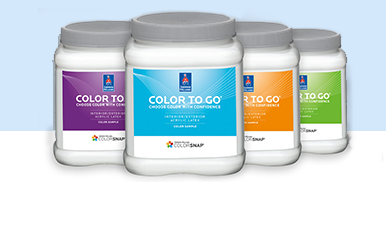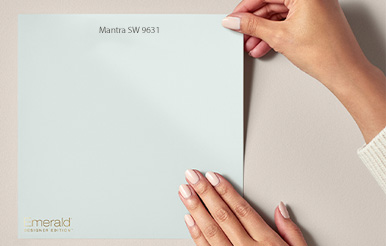Recent Questions
Answer Most products are ready to go right out of the can with no reduction necessary. Some products can be reduced to some degree. The product's data page will indicate the maximum reduction allowed if any and the correct type of reducer. Please note that reducing a paint product past the recommended levels would produce a solution that may not offer the same performance characteristics as those indicated on the product's data page. Always use the recommended solvent and never reduce past the amounts recommended by the product's manufacturer.
Answer Until a few years ago, painting needed to done when temperatures were going to be above 50° Fahrenheit. However, with advances made in waterborne technologies, products like Duration®, Resilience®, SuperPaint®, A-100® latex, in addition to WoodScapes® products can be applied when temperatures are as low as 35º F. Please note that surface, air and product temperatures must be at or above 35º F and that environmental conditions during and after painting need to be considered. Stable conditions and temperatures above 35º F are needed early in the paint's drying schedule. The first 48 hours could be critical to successful drying.
Answer From a purely time savings consideration, airless spray is the most efficient way of delivering a paint product to a substrate. Also, when painting areas that have deep crevices, as in the case of wood shingles on the side of a home, this method can get the product into otherwise hard to reach areas. However, when coating wood surfaces that have a significant variation in porosity and/or when coating cementitious surfaces with a thicker paint coating, back brushing or rolling can be recommended so that the material can be driven deeper into the substrate and so that the overall coat can be uniform.
Answer This is often called a feature or accent wall. While this could depend on the overall space, the wall that comes into view opposite the main entrance is in most cases selected as the feature wall and should be the one to receive the special treatment.1
Answer If the imperfections are not too pronounced, sponge painting with multiple colors can hide a multitude of "sins." The greater the contrast among the colors used in the sponge painting process, the more the overall effect will hide imperfections.
Answer A common problem with existing textured paint is that it can be water-soluble. If you use a waterborne product directly over such a surface, it may cause the existing texture to begin to soften and fall off of the surface. Test a fast-drying alkyd primer on the surface. Alkyds have the best chance of not wetting the texture paint. If the alkyd primer does not prevent the softening of the texture, then you may have to consider complete removal of the existing texture and reapplication of a new coat.Application of a fresh coat by roller may be easiest for most; however, in some cases it may not be possible to roll over texture paint as this, too, could cause it to come off. In such cases, application via airless spray may need to be considered. Test the application method over a small area prior to painting the entire ceiling.
Answer If this is a concrete slab on grade, check to ensure that the surface does not have a moisture problem prior to considering an opaque coating.Tape a 2-foot square plastic sheet to the floor (use duct tape and tape around the entire perimeter of the plastic sheet). Leave in place on the floor for one or two days. Then, check to see if moisture is present between the floor and the plastic. If moisture is present, painting should not be attempted. If the area is still dry, then the surface can be painted. Clean the surface to remove all contaminants.If the surface is smooth, etch the surface to create a profile with the H&C Clean and Etch or similar product. To resist hot tire pick-up we recommend a polyamide two part epoxy.
Answer As you can imagine, this can be open to debate. For the most part, however, the ceiling and walls are primed prior to installing the trim. Naturally, the ceilings are done first, and then the wall. Once the trim is installed and the edges caulked, the trim is primed and finish coated. The trim is therefore coated last. Even when repainting a similar order is followed. Ceiling first, walls second, trim last. If the trim were painted first, splatter from the roller could end up on the freshly painted trim. Since time is of the essence in repaint work, there is not usually enough time between painting the trim and painting the wall to use masking tape on the freshly applied paint.
Answer Black or white china bristle brushes should be used when working with oil-base products. (Do not use these when working with waterborne coatings because the water will soak into the bristle and damage the brush.) When working with oil-base paints, the softer nature of the natural bristle will promote better release of the coating onto the surface and will generate an overall better finish. White china bristle brushes are most commonly used when working with less viscous products, such as interior, oil-based stains and polyurethanes.
Answer Nylon, polyester and nylon/polyester blended brushes are the applicator of choice when working with waterborne materials. These products will pick up and release waterborne coatings better than natural bristle brushes. The filaments will not absorb water and become damaged from use with such products. You will find a wide range in pricing, and the higher quality brushes are typically well worth the higher price. These will often have differently shaped bristles. In addition the bristles will be laser split to improve the overall release of a paint film. In addition, some are chemically treated to facilitate clean up after painting.
Answer Vinyl flooring and vinyl tile surfaces should not be painted. The composition of these surfaces prevents proper adhesion of paints. Direct impact, abrasion from foot traffic as well as flexing of the floor can result.
Answer Factors such as actual temperatures, humidity levels and even air movement all contribute to the drying of an alkyd resin. In addition, the thickness of the newly applied coat and the porosity of the surface will also impact the time needed for an oil-base product to set up.However, it could be said that the first 8 hours or so of the cure time is critical. If adverse weather was imminent (within 8 hours) we would recommend waiting until conditions improve. It should be noted that although oil-base products are rather resilient, as a rule, we would not recommend painting if rain is in the immediate forecast.
Answer Yes. While products are optimized for application in a wide range of environmental conditions, at extremes the application may need to be adjusted. If surface, air and material temperatures are too high or too low (ranges are indicated on the data page or product label), then these conditions could impact products, drying, leveling and the overall condition of the finish coat.In higher temperatures, a product may even begin to set up on the brush, causing dragging and preventing proper leveling. Such conditions will result in a finish that is not as smooth as it could be and brush stokes will be visible. In these conditions, you might need to add solvent to slow drying.In cooler temperatures, slow drying may make a product more susceptible to sagging. In these conditions, apply thinner coats or use a product that can handle the temperature.
Answer Several factors should be considered when selecting the right roller cover. Viscosity of the product, porosity and texture of the substrate, as well as desired finish. A more viscous paint will require a cover that can hold more product. In these cases, a heavier nap of 1/2" or greater may be needed. Also, when the surface is porous or textured, a heavier nap covers would be needed. However, when the surface is very smooth and you want to maximize the overall sheen and finish, a thinner nap, such as 1/4" or even a mohair 3/16", may be recommended. Ultimately, refer to the product data page and/or product label for a recommendation on which type of cover to use. Be sure to stay within the recommended range. (1/4", 3/8", 1/2" nap pile).
Answer Because of their very nature, pad applicators are designed for smooth surfaces. In addition, because they tend not to hold enough paint to cover large areas, they are primarily used on small surfaces or when working with less viscous materials (such as stains or varnishes). Pad applicators are ideal if you want to limit brush strokes and/or the texture created by rollers. Some pad applicators (for example, the ones with wheels on one side) are specifically made for trimming out around a ceiling or trim line.
Answer It is easiest to use a heavy nap roller (1" or even 1 1/4" nap). Plan to roll over both sides to be sure to cover the whole area. You should plan on a lot of drips, so use tarps to catch excess paint. If possible, spray application will provide a better overall finish and will be much faster; however, consideration should be given to controlling the spray. Some painters have a partner move along the opposite side of the fence with a shield to catch the overspray.
Answer In most cases, textured paint is applied to a sheetrock wall after only one or two coats of joint compound was applied. Because the plan was to texture, the contractor did not prepare the wall for a smooth finish. In most cases once loose textured paint is removed, a fresh coat of texture would need to be applied in order to hide any imperfections.Most textured paint is water-soluble and can be softened by soaking with warm water or stripped with a conventional paint stripper. However, it may be easier to scrape the surface while it is still dry. Be sure to wear eye protection and a dust mask as scraping will create dust. Scraping can also be rather messy, so be sure to cover or remove anything that could be damaged in the process. Once the existing texture is removed, the substrate can be patched as needed and primed. Follow with fresh texture, or, if the surface is smooth enough after patching, you can follow with a standard ceiling paint.
Answer First, it is important to make sure that this floor will accept a paint film. If the floor tends to have moisture coming up through the surface then painting would not be recommended. Even it you feel that the floor is dry, we recommend that you test for moisture by taping a piece of 3-mil plastic (1-2 ft square) to the surface. Make sure that the tape seals the plastic on all sides so no air can get between the plastic and the floor. See if any moisture develops in the next day or two. If the area under the plastic stays dry, then painting the floor should be okay.Remove all form release agents, curing compounds, salts, efflorescence, laitance, and other foreign matter. If the floor surface is smooth, then etching will be necessary.Our Porch and Floor Enamel is a good choice for such surfaces. It has a gloss finish, offers water clean-up of brushes and rollers used in its application and has fewer odors. Two coats are recommended. Follow all directions on label.
Answer After removing the hardware, clean the surfaces thoroughly with a heavy duty cleaner (a TSP substitute) or other good detergent will work. It is imperative that greases and oil build-up is removed prior to continuing with the next steps. Often furniture polish or some other wax-based material may have been used on these. If waxes exist, remove with ammoniated cleaners. Sanding the surface prior to painting will help promote adhesion. Follow with a block resisting latex paint like our Pro Classic Waterborne or oil-based semi gloss. Naturally it would be good to test this system first on a small section prior to tackling the whole project.
Answer After removing the hardware, clean the surfaces thoroughly with a heavy duty cleaner (a TSP substitute) or other good detergent will work. It is imperative that greases and oil build-up is removed prior to continuing with the next steps. Often furniture polish or some other wax-based material may have been used on these. If waxes exist, remove with ammoniated cleaners. Once clean, sand the surface to bare wood then apply an alkyd wood primer for best adhesion. The oil base primer will also help prevent any bleeding issues. Follow with a block resisting latex paint like our Pro Classic Waterborne or oil-based semi gloss. Naturally it would be good to test this system first on a small section prior to tackling the whole project.
Answer New plaster typically requires 30 days to cure. The Loxon Masonry Primer can be applied to new plaster that has dried for at least 7 days with temperatures around 77 degrees F and relative humidity around 50%. Lower temperatures or higher humidity will extend the dry time of 7 days. Soft, porous, or powdery plaster should be treated with a solution of 1 pint household vinegar to 1 gallon of water. Repeat until the surface is hard, rinse with water and allow to dry before painting.
Answer Scrape off all loose and peeling paint from the surface and wash the walls to remove any glue residue. If the drywall paper is damaged remove any loose paper and then use 80-120 grit sandpaper to lightly sand the area, this will feather the edges where the paper was removed. Then apply one coat of Sherwin-Williams Drywall Conditioner to the damaged areas. Our Drywall Conditioner is a clear, acrylic coating for sealing torn, ripped, and gouges drywall which occurs when wallcovering is removed. This product seals the torn facing or broken area and provides a suitable base for drywall patch, preventing blistering of the drywall paper under the patch. Allow 3 hours drying time before applying a skim coat, patch, new wallcovering, or primer to the surface.
Answer Vinyl surfaces can sometimes be difficult to coat. The composition of some of these surfaces prevents proper adhesion of paints. For best results we always recommend testing the system prior to taking on the whole job.First clean the surfaces thoroughly. Our Heavy Duty Cleaner (a TSP substitute) or other good detergent will work. Often, even on this material, someone may have used polish or some other wax-based material making this cleaning necessary. If waxes exist, remove with ammoniated cleaners. Test the Sherwin-Williams Multi-Purpose Latex Primer on the surface for adhesion. If the primer dries without lifting or blistering, you may then proceed and finish with a good quality latex paint like Super Paint or Duration.









